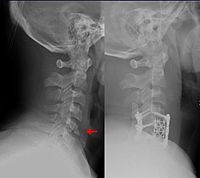
Photo from wikipedia
Purpose Intramedullary nailing is the standard treatment of trochanteric fractures. Mechanical failure such as cut-out and cut-through are associated with high rates of revision surgery, functional impairment, and mortality. The… Click to show full abstract
Purpose Intramedullary nailing is the standard treatment of trochanteric fractures. Mechanical failure such as cut-out and cut-through are associated with high rates of revision surgery, functional impairment, and mortality. The aim of the study was to evaluate the rate of mechanical failure of the cement augmented screws of Trochanteric Fixation Nail-Advanced (TFNA) nails. Patients and methods A descriptive, retrospective, multi-operator, single-centre study was performed at our level 1 trauma centre between June 2019 and June 2020. Patients were included if they were > 65 years of age, presented with a trochanteric fracture treated with an augmented TFNA nail with 6 months of follow-up. The primary outcome was fixation failure rate (cut-out or cut-through) at three and six post-operative months. Secondary endpoints were intra-operative data, clinical scores, and radiographic analysis. Results Forty-five patients (38 women and 7 men) were analysed. The mean age was 82.84 years (65–102, 9.50). There were no instances of mechanical failure in our series, after either three or six months of follow-up. No patient exhibited cut-out or cut-through. The mean amount of cement injected was 4.72 mL (3–6; 1.05). The mean length of surgery was 37.59 min (25–55; 6.48), and the mean intra-operative radiation exposure was 91.47 cGycm 2 (25.04–201.81; 51.40) for a mean duration of 43.11 s (17–86; 16.81). The mean duration of hospitalisation was 6.38 days (2–11; 2.27). Conclusions Our clinical results suggest that cement-augmented TFNA screws can be successfully used in the management of trochanteric fractures in patients > 65 years of age.
Journal Title: International Orthopaedics
Year Published: 2022
Link to full text (if available)
Share on Social Media: Sign Up to like & get
recommendations!